GLBenchmark 2.5 Performance on iOS and Android Devices
by Anand Lal Shimpi & Brian Klug on July 31, 2012 8:00 PM EST- Posted in
- Smartphones
- GLBenchmark
- Mobile
- Tablets
- SoCs
Smartphone Performance in GLBenchmark 2.5
Thus far there's no A5X equivalent in an iPhone, making the A5 the highest performing option from Apple in these charts. Clock speeds (and likely power management profiles) are lower on the A5 in the iPhone 4S than in the iPad 2, so performance should be a bit lower here than what you saw on the previous page.
The A5 has a significant fill rate advantage, however triangle throughput ranges from middle of the road to barely in the lead. In many cases NVIDIA's Tegra 3 or Qualcomm's S4 pulls ahead in triangle throughput.
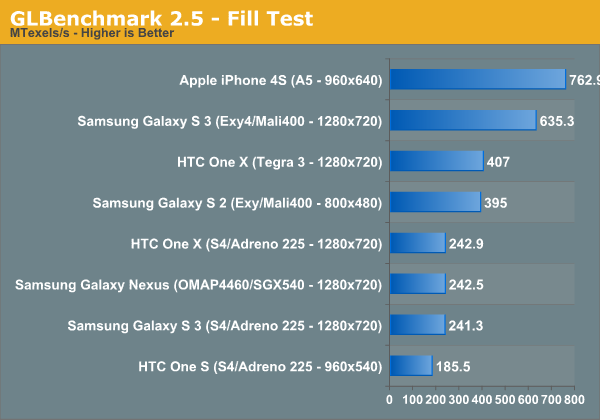
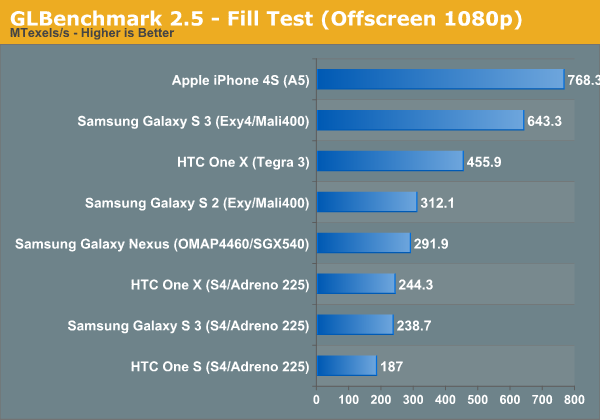
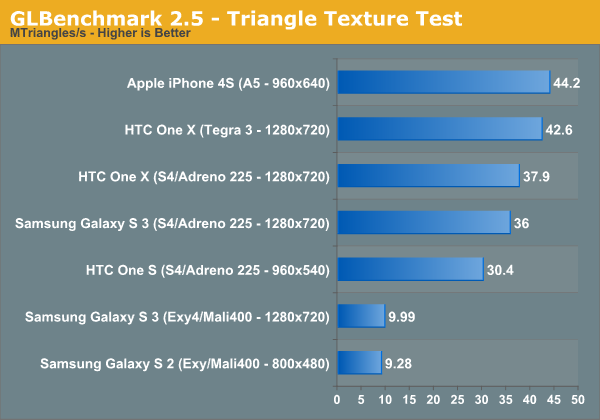
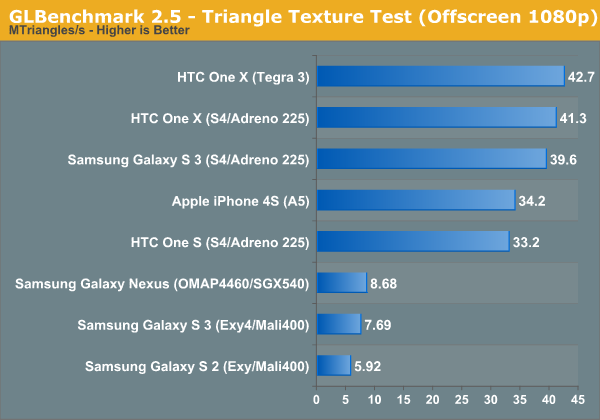

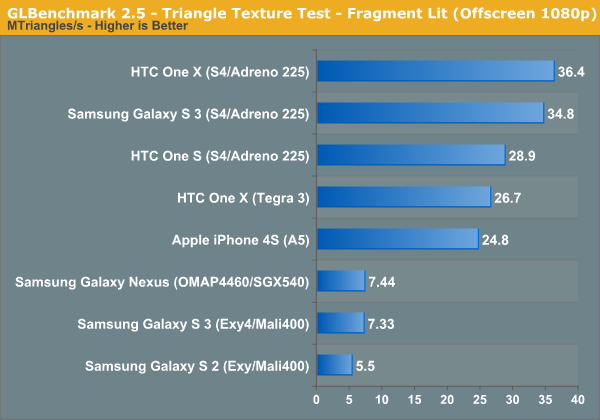
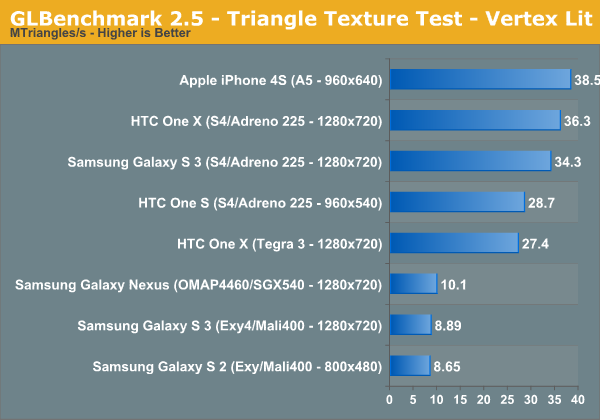
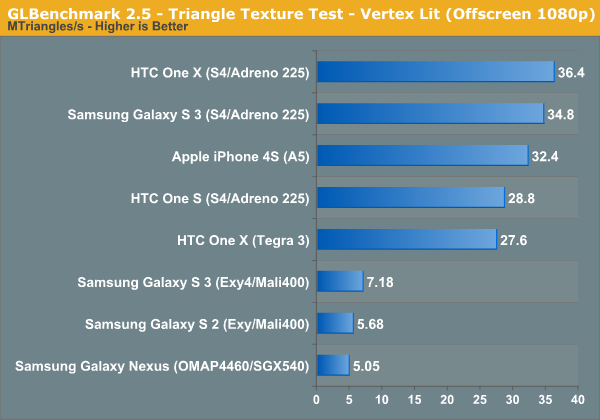
Overall performance using Egypt HD puts all three of the S4 based devices ahead of the iPhone 4S. Ratchet up the resolution to 1080p and the standings don't really change, although the Exynos 4 quad moves up in the world a bit.

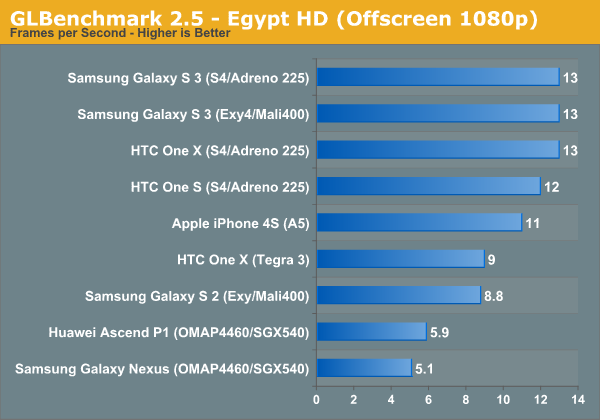
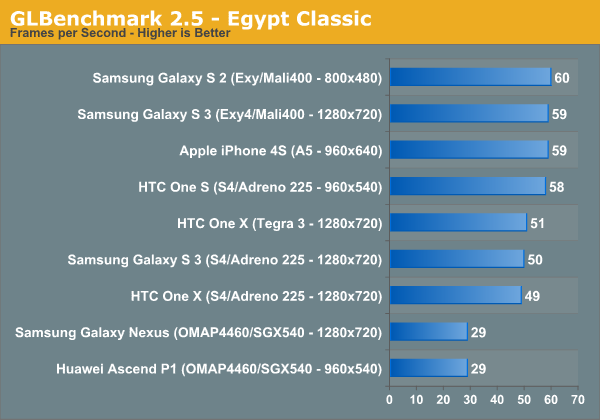

Final Words
The addition of iOS results to our GLBenchmark 2.5 charts doesn't provide much surprise. On the tablet side, Apple's A5X continues to be the benchmark to beat. The A5 however, especially in the iPhone 4S, shows its age in Egypt HD. Qualcomm's S4 and Samsung's Exynos 4 Quad both offer better graphics performance than the A5 in Egypt HD. The pressure is on for Apple to deliver something between the A5 and A5X in the next generation iPhone this fall.










57 Comments
View All Comments
darkcrayon - Wednesday, August 1, 2012 - link
Designed by Apple.Doesn't Samsung pretty much reserve the Exynos exclusively for (some of) their own tablets and phones?
UpSpin - Thursday, August 2, 2012 - link
The Meizu MX uses an Exynos. I think Samsung will gladly license their SoCs to others, but currently the others prefer Krait, OMAP, Tegra, ... Probably because Samsung doesn't promote their Exynos and does not support it as good for third parties as the others do with their SoCs.UltraTech79 - Wednesday, August 8, 2012 - link
Yeah so sad, unless you're not full of yourself and buy the product that is best regardless of your weak bs brand loyalties.Draiko - Wednesday, August 1, 2012 - link
Could there be a nasty performance hit due to Android?Here's what I'm seeing:
Based on specs, clockspeeds, and resolution differences, the Apple A5 (SGX543MP2) in the iPad 2 should be posting ~2.5x-3x better performance vs the OMAP4430's SGX540 GPU in the Xyboard.
The A5 seems to be posting 4x-5x performance over the OMAP4430.
There are very few differences between the SGX540 and SGX543 on paper... the 543 supporting OpenGL 2.1 vs 2.0 for example but it doesn't seem like those differences would explain the actual performance differences we're seeing here.
Am I missing something or could this suggest that the hardware isn't really showing its' true colors on Android?
UpSpin - Thursday, August 2, 2012 - link
The SGX543MP2 is three times faster than the SGX540.http://www.anandtech.com/show/5688/apple-ipad-2012...
Now you can change the clock speed to further improve things. And then there's the thing with the memory. The wider the memory bandwidth the faster the GPU (see performance boost in asus infinity due to the faster RAM). I don't know the numbers, but I it's likely that the A5 has more memory bandwidth.
And finally it's the software. I don't think it's right to say: 'performance hit due to Android', because they use a native programming language to code the benchmarks on Android, so no VM overhead. It's more how they optimize it for the specific operating system. Because the source code is unknown they can do whatever they want, they don't have to stay fair or invest the same amount of energy in optimizing the app for the Tegra 3 or Omap processor as they did for the Apple SoCs. Such benchmarks, especially if they get run on totally different and incompatible operating systems are always difficult to compare. Additionally do different GPUs feature different special features, which enhance the image quality. But how can you compare those incompatible features with other SoCs which use different techniques? So those benchmarks only test the raw processing power, games might still look worse on a faste GPU due to the lack of those special features (see comparisons between Tegra 3 and iOS versions of games, the same games for Tegra 3 have water effects, smoke, ..., while the other versions don't)
mevensen - Friday, August 3, 2012 - link
Can't that be said about most Android software vs iOS software as well? iOS provides a mouch more limited set of configurations that need to be addressed by developers for optimal performance. Android developers have to account for much wider variety, decreasing the likelihood that any one product will be optimized (possible exception being those products under the Tegra banner, that receive special attention/support by nVidia). This means that the synthetic benchmarks actually mimic the marketplace in that iOS software is more likely to be optimized vs an Android counterpart..shaolin95 - Friday, August 3, 2012 - link
My International Note overlocking the GPU to 400mhz gets 51fps on that last Egypt test offscreen.That is the reason I am holding for a Note 2 and hopefully featuring an upgrade in GPU.